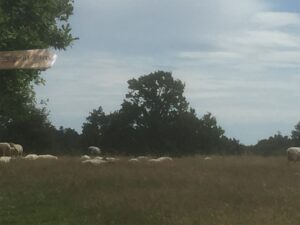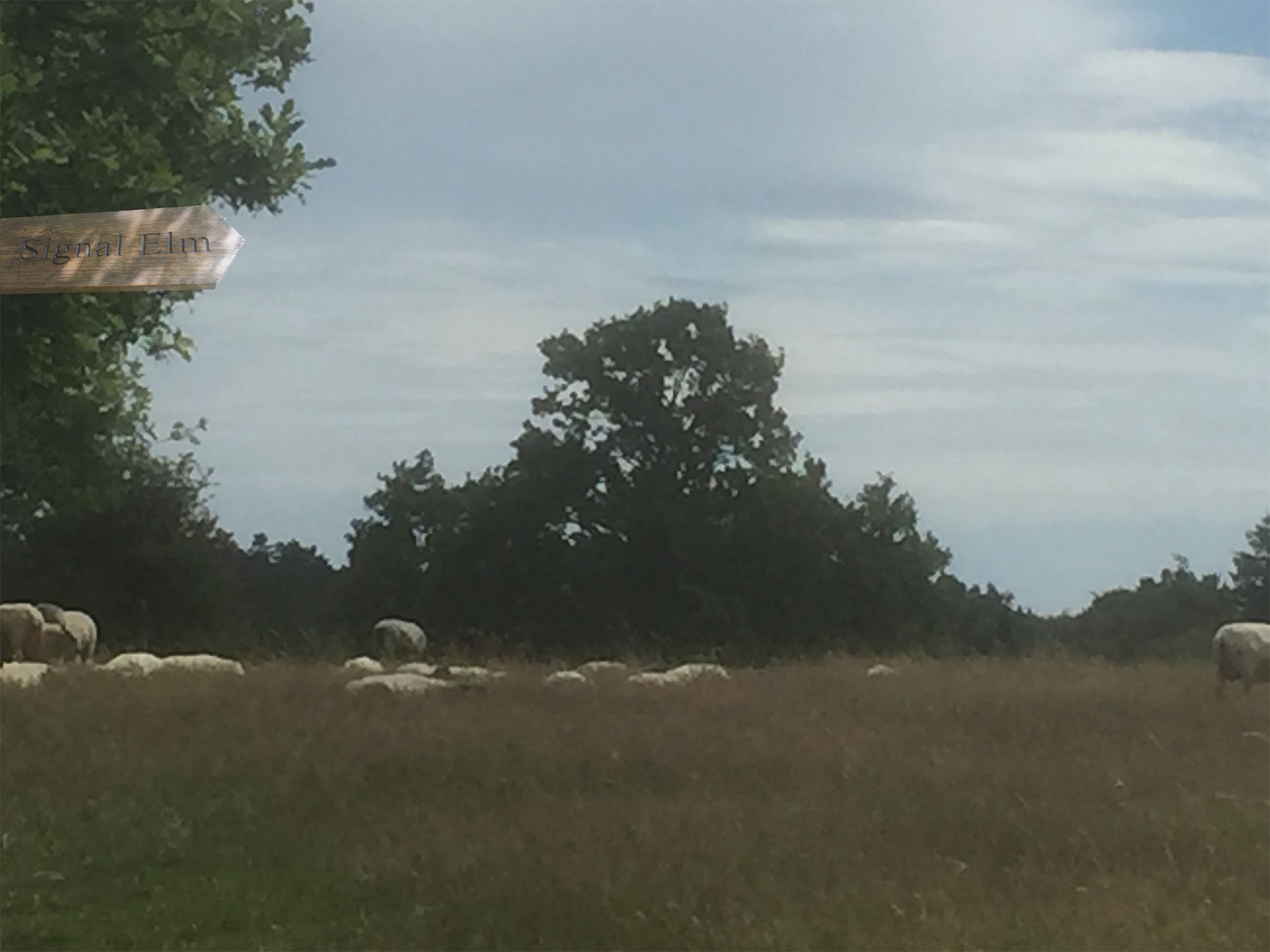 3 September 2020
3 September 2020
The Signal Elm
by Philip Throp
Back in the mid-60s one of my A-level set books was The Collected Poems of Matthew Arnold. Two key inter-related poems were “The Scholar Gipsy” and “Thyrsis”. The former is about a hill-walk often undertaken by the Victorian Romantic scholar-poet with his fellow-poet A. H. Clough. “Thyrsis” describes a repeat of the walk, many years later, after Clough has died, in which Arnold addresses the departed Clough, and at the end of the poem receives an answer, always printed in italics:
Why faintest thou! I wander’d till I died.
Roam on! The light we sought is shining still.
Dost thou ask proof? Our tree yet crowns the hill,
Our Scholar travels yet the loved hill-side.
Move on 50 years in my life, my English literature studies are long-forgotten, and my wife and I rent a house in the midst of woods close to the centre of Oxford (!), known as Boars Hill. After bringing in our belongings we take our very first exploratory walk of its surroundings. On a relatively unbeaten and overgrown woodland path, less than 300 metres from the house, we find a stone seat. We sit on the seat and then realise it has an inscription carved into the stone: “Why faintest thou….,” the full four closing lines from the long-forgotten poem assail my memory. Amazing coincidence! We walk on further through the woods and come to the edge of the woods and an open field. Nameboard: “Matthew Arnold’s Field.”
And then I recall that the two poems are about a walk up onto the neighbouring hills and beyond, starting from the bustle of the Victorian Oxford streets. Arnold was a scholar and don at Balliol College, where graduates include seminal 18th century economist Adam Smith, author of The Wealth of Nations; and, somewhat later, Boris Johnson.
“The Scholar Gipsy” relates how during the walk the two poets recall a well-known Oxford story from the 1660s in which a scholar suddenly abandons his studies to join a wandering gipsy troupe, and never returns.
The poem goes on to relate how the escapee is then seen fleetingly by country walkers in the shire over the following centuries, in gipsy garb, without regret but still searching. The poet envies the scholar gipsy’s isolation from the developing material Victorian world, which distracts other mortals from “the search”:
Thou waitest for the spark from heaven! And we
Light half-believers of our casual creeds,
Who never deeply felt, nor clearly will’d
Whose insight never has borne fruit in deeds
………………..Ah, do not we, wanderer! await it too?
As a 16 year old schoolboy I was told the scholar gypsy is searching for “truth.” (I’m not sure if this has a capital T or not). I expect we all have our own interpretations of what is the object of the search. Written in 1853, this is when Victorian society is really examining itself. The ethics of industrialisation, the growth of non-conformist religion, and in which direction the established Anglican church should move, by then seen to be too much the organ of State, and the beginnings of the questioning of established faith systems, soon to be exacerbated by Darwin’s Origin of Species. Is the scholar seeking a religious truth which he, like other scholars, has failed to achieve from study of texts? (To even be allowed to study or teach at Oxbridge, a student had to sign up to the Articles and beliefs of the Church of England).
So maybe it is the search for a soul-fulfilling unambitious Zen-type life, maybe an alternative to an academic-based search for religious belief. Or maybe you, dear reader, have another interpretation which fits for you. Art’s value is in whatever it does for its receiver, rather than what the artist himself necessarily intended.
Or if we take an artist’s point of view, does the Scholar Gipsy’s breakout from academe symbolise the search for direct artistic inspiration rather than laborious creative effort? Or the ability to fashion words or other artistic creation that can move human minds/emotions?—the Romantic imperative:
Whereat he answer’d, that the gipsy-crew,
His mates, had arts to rule as they desired
The workings of men’s brains,
And they can bind them to what thoughts they will.
“And I,” he said, “the secret of their art,
When fully learn’d, will to the world impart;
But it needs heaven-sent moments for this skill.”
This is relevant, because Arnold is often thought of as being an academic, workmanlike, but definitely not a passionate Romantic. His father was the headmaster of Rugby School who featured in Tom Brown’s Schooldays, and Arnold had a job travelling the country alone (mainly by rail) as an H M Inspector of Schools. Clough, though his contemporary good repute has not survived, was in his day a more appreciated author than Arnold was. His poetry is more inspired, direct, passionate, something which Arnold well knew that he was not. Clearly from the two poems he looked up to Clough as a poet, even if Clough’s background and social status were far inferior to Arnold’s. It may be revealing that Clough’s widow intensely disliked Arnold, saying that he never visited her on or after Clough’s death, and that the metaphor of the Scholar Gipsy and the idea to use it in a poem had been Clough’s part of the discussion, not Arnold’s. There is an interesting irony here as we move to the poem “Thyrsis” (thyrsis being the name adopted for Clough for the purposes of the poem, a typically Victorian poetic practice of using a Classical name to denote a contemporary character.
Incidentally, it is in Thyrsis that Arnold coins the phrase “that sweet city WITH HER DREAMING SPIRES”. It is revealed in this elegiac poem that when sharing their walks, discussing the 17th century escapee, the two poets had attached to a particular elm tree on Boars Hill the notion that: “while it stood, we said/ Our friend the Gipsy-Scholar was not dead;/WHILE THE TREE LIVED, HE IN THESE FIELDS LIVED ON/ Despair I will not, while I yet descry/That lonely tree against the Western sky”.
The poem “Thyrsis” relates how Arnold latterly (after the death of his companion, Clough), had trouble finding the tree, (loss of faith/belief?/ loss of personal values or peace of mind with the onset of the Industrial Revolution?) but eventually Arnold locates the tree, their symbol of ongoing search, and there he is responded to by Clough’s spirit with my familiar lines: “Why faintest thou……? The light we sought is shining still/ Our scholar wanders yet the loved hillside.”
The Signal Elm as the symbolic icon of enduring inspiration, belief, even faith, made this a much-sought location for Victorians and subsequent generations. There has been much controversy and much academic ink spilled over the identification of the correct tree and whether or not it is still there. The Oxford Preservation Trust currently has a “Signal Elm” signpost nearby. Many things about the location ring true. It is a single tree, standing alone. Its location would be by the well-known footpath from Oxford up to Boars Hill and the places beyond named in the poem. Arnold’s daughter wrote years later that she had seen it more than once from a train leaving Oxford station for London, which would place it in its present location, (though because of a rise in the land just before it I have my doubts one can identify it from the train). On the debit side in this debate, with the poem stating the tree is beside this main footpath, why does Arnold have trouble finding it on his later visit? Or is this just a poetic conceit to give the poem some much-needed tension? Most of all, as the sharp-eyed will discern from the photo, the designated tree is not even an elm! The exalted “Signal Elm” is an oak tree! Did neither Clough nor Arnold, both committed country-walkers, nor Arnold’s daughter, notice this elementary error, which has been cited by doubters for over 150 years? On the other hand, whilst at Boars Hill (we no longer live there), a local told me he believes that in Victorian times oak trees were often trimmed into a shape very similar to an elm, so a mistake of species by the poet(s) IS possible.
And of course the identification of real locations for artistic “inventions” is mostly not a worthwhile exercise. What is of much more interest is what the icon represents.
NEXT TIME: VW AND THE SCHOLAR GIPSY


